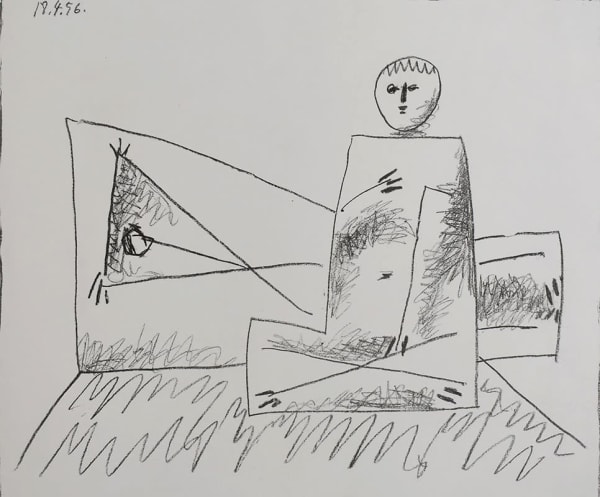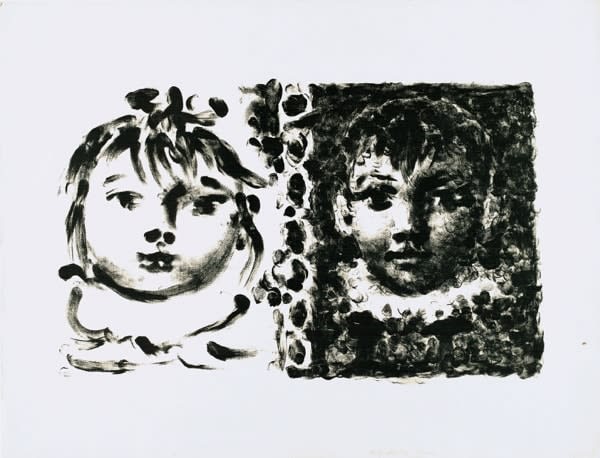
Pablo Picasso
Signed in the litho stone
90 x 63 cm
Grande Maternité (1963) is one of Pablo Picasso’s most tender and emotionally resonant lithographs—a moving portrayal of maternal intimacy rendered in the artist’s late, fluid line. Created in the final decade of his life, this image exemplifies both the thematic richness and technical mastery that defined Picasso’s late-period work in printmaking. Combining minimalist drawing with subtle color accents, Grande Maternité speaks to universal ideas of love, care, and life, filtered through the lens of a modern master still evolving in his eighties.
The composition depicts a serene, monumental woman nursing her child. Their bodies are entangled in a rhythmic curve that spirals inward, evoking unity and emotional closeness. The figures are outlined in a delicate, continuous black line, with sparse yet expressive detail. The woman's features are stylized—Picasso’s signature treatment of the nose, lips, and eyes creating a timeless, almost archetypal face. Her crown of ivy, whimsically colored in green with touches of red and blue, lends a mythical and pastoral quality, echoing classical depictions of fertility and nature.
Color is sparingly but effectively used: green foliage in the background is hastily hatched with crayon or pastel-like strokes, enhancing the intimacy of the moment without overwhelming the drawing’s elegant simplicity. The baby, snuggled into the curve of the mother’s arms, gazes upward with a small, coiled hand and puckered lips—a gesture that captures the liveliness of new life.
The use of negative space is vital. Picasso allows the whiteness of the paper to breathe between the forms, creating volume through suggestion rather than detail. The simplicity of line belies the complexity of emotion conveyed—proof of Picasso’s unique ability to distill essence from form.
Motherhood is a recurring theme in Picasso’s work, appearing throughout his Blue Period, neoclassical phase, and into his later drawings and prints. In Grande Maternité, the maternal figure is neither stylized abstraction nor symbolic vessel—she is full of presence and humanity. Unlike some of his earlier, more psychologically charged portrayals of motherhood, this image exudes harmony and peace.
By 1963, Picasso was reflecting deeply on themes of creation, continuity, and mortality. His own children and domestic life in the south of France influenced a series of intimate drawings and prints. Grande Maternité fits within this context: a personal, poetic image that celebrates life and lineage through the most ancient of bonds.
This work is a testament to Picasso’s lifelong engagement with printmaking, and specifically, to his exceptional fluency in lithography. Lithography, which involves drawing directly onto a stone or plate with a greasy medium, allowed Picasso to retain the spontaneity of drawing while achieving a refined, reproducible image. He often worked in collaboration with the printers at Mourlot in Paris, experimenting boldly with layers, textures, and hand-coloring.
In Grande Maternité, his control is evident in the fine modulation of line, the balance of form and blank space, and the integration of color. Rather than using lithography to merely reproduce his paintings, Picasso treated it as a medium of invention, capable of equal emotional and aesthetic power.
Grande Maternité is a luminous example of late Picasso: stripped of ego, rich in feeling, and executed with supreme confidence. It reveals the artist not as a provocateur or revolutionary, but as a humanist and poet, still in love with the act of creation. Through a few elegant lines and dashes of color, Picasso affirms that the most profound truths in art—like the bond between mother and child—need only the simplest tools to be expressed.
For more information, contact our galleries via the inquiry form below.
-
 Pablo PicassoLe Corsage à Carreaux, 1949
Pablo PicassoLe Corsage à Carreaux, 1949 -
 Pablo PicassoJacqueline Profile to the Right, 1958
Pablo PicassoJacqueline Profile to the Right, 1958 -
 Pablo PicassoLes Demoiselles d'Avignon, 1953
Pablo PicassoLes Demoiselles d'Avignon, 1953 -
 Pablo PicassoBuste au fond étoilé (Bust with Star Background), 1949
Pablo PicassoBuste au fond étoilé (Bust with Star Background), 1949 -
 Pablo PicassoJeu De La Cape (Bloch 1015), 1961
Pablo PicassoJeu De La Cape (Bloch 1015), 1961 -
 Pablo PicassoTete De Femme Fond Noir, 1946
Pablo PicassoTete De Femme Fond Noir, 1946 -
 Pablo PicassoBuste de Femme au Corsage Blanc (Jacqueline de Profil), 1957
Pablo PicassoBuste de Femme au Corsage Blanc (Jacqueline de Profil), 1957 -
 Pablo PicassoReclining Man and Crouching Woman | Homme couché et femme accroupie, 1956
Pablo PicassoReclining Man and Crouching Woman | Homme couché et femme accroupie, 1956 -
 Pablo PicassoThe Little Artist (Draughtsman) | Le petit dessinateur, 1954
Pablo PicassoThe Little Artist (Draughtsman) | Le petit dessinateur, 1954 -
 Pablo PicassoFrançoise Sur Fond Gris, 1950
Pablo PicassoFrançoise Sur Fond Gris, 1950 -
 Pablo PicassoFemme à L'Italienne d'après le tableau de Victor Orsel (Bloch 740), 1953
Pablo PicassoFemme à L'Italienne d'après le tableau de Victor Orsel (Bloch 740), 1953 -
 Pablo PicassoGrand Nature Mort au Compotier, 1947
Pablo PicassoGrand Nature Mort au Compotier, 1947 -
 Pablo PicassoAfter The Embrace, 1901
Pablo PicassoAfter The Embrace, 1901 -
 Pablo PicassoProfil de Femme
Pablo PicassoProfil de Femme -
 Pablo PicassoProfil au fond noir, 1947
Pablo PicassoProfil au fond noir, 1947 -
 Pablo PicassoRonde de la Jeunesse, 1961
Pablo PicassoRonde de la Jeunesse, 1961 -
 Pablo PicassoFemme à la Robe
Pablo PicassoFemme à la Robe -
 Pablo PicassoJacqueline with Roses, 1956
Pablo PicassoJacqueline with Roses, 1956 -
 Pablo PicassoPaloma et Claude, 1950
Pablo PicassoPaloma et Claude, 1950 -
 Pablo PicassoBuste, 1957
Pablo PicassoBuste, 1957 -
 Pablo PicassoPortrait de Femme II, 1955
Pablo PicassoPortrait de Femme II, 1955 -
 Pablo PicassoTête de Jeune Fille – Portrait de Françoise, 1949
Pablo PicassoTête de Jeune Fille – Portrait de Françoise, 1949 -
 Pablo PicassoJeunesse, 1950
Pablo PicassoJeunesse, 1950
Join our mailing list
* denotes required fields
We will process the personal data you have supplied in accordance with our privacy policy (available on request). You can unsubscribe or change your preferences at any time by clicking the link in our emails.
This website uses cookies
This site uses cookies to help make it more useful to you. Find out more about cookies.






















